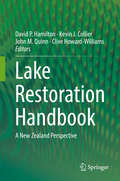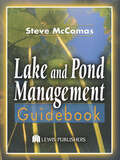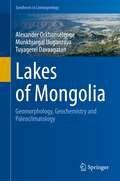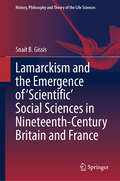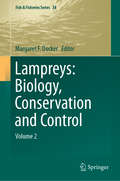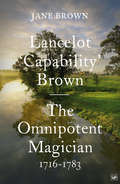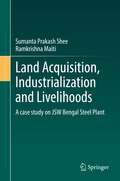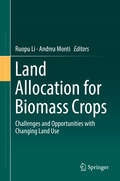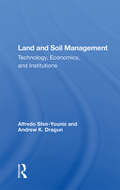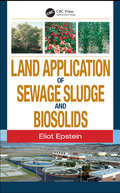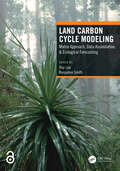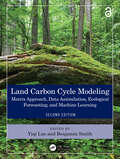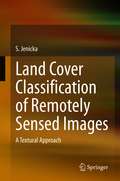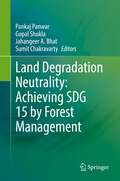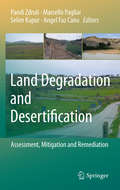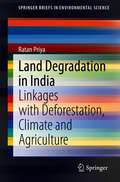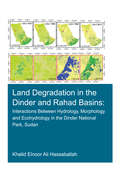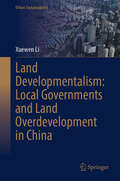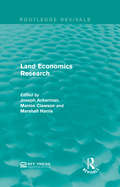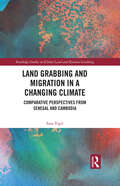- Table View
- List View
Lake Restoration Handbook: A New Zealand Perspective
by David P. Hamilton Kevin J. Collier John M. Quinn Clive Howard-WilliamsLakes across the globe require help. The Lake Restoration Handbook: A New Zealand Perspective addresses this need through a series of chapters that draw on recent advances in modelling and monitoring tools, citizen science and First Peoples’ roles, catchment and lake-focused restoration techniques, and policy implementation. New Zealand lakes, like lakes across the globe, are subject to multiple pressures that have increased in severity and scale as land use has intensified, invasive species have spread and global climate change becomes manifest. This books builds on the popular Lake Managers Handbook (1987), which provided guidance on undertaking investigations into, and understanding lake ecosystems in New Zealand. The Lake Restoration Handbook: A New Zealand Perspective synthesises contemporary issues related to lake restoration and rehabilitation, integrated with social science and cultural viewpoints, and complemented by authoritative topic-area summaries by renowned scientists and practitioners from across the globe. The book examines the progress of lake restoration and the new and emerging tools available to managers for predicting and effecting change. The book will be a valuable resource for natural and social scientists, policy writers, lake managers, and anyone interested in the health of lake ecosystems.
Lake Urmia: A Hypersaline Waterbody in a Drying Climate (The Handbook of Environmental Chemistry #123)
by Evgeniy V. Yakushev Peygham GhaffariThis book provides a holistic review of the environmental status of Lake Urmia in terms of its hydrodynamic, chemical, and ecological properties. Lake Urmia is a shallow landlocked hypersaline water body located in the northwest part of Iran, and it is known as one of the largest continental salt lakes in the world. Divided into 16 chapters, the book gathers leading experts from various scientific disciplines, and it covers past and current characteristics of the lake and traces projections on how the water quantity, quality, chemical, and ecological state of Lake Urmia Basin can develop in the future. The book outcomes are based on the analyses of the data of observations and unique models that were elaborated for the Lake Urmia system development studies. Particular attention is given to the basin drought in response to anthropogenic drivers and environmental pressures such as climate variability and climate change and their impact on the aquatic environment. The impact of water conveyance on Lake Urmia to improve the physical, chemical, and biological natural state is also discussed in this book, where an intensive and challenging observation plan in this harsh environment is combined with uniquely coupled and adopted hydrodynamical-biogeochemical models. Given its scope, the book offers an invaluable source of information for researchers, students, and environmental managers interested in the Lake Urmia environment.
Lake Victoria Monitored from Space
by Joseph AwangeThis book employs a suite of remotely sensed products and advanced technologies to provide the first comprehensive space-based sensing of Lake Victoria, the world’s second largest freshwater lake that supports a livelihood of more than 42 million people, modulates regional climate, but faces myriads of challenges. Proper understanding of the lake and changes in its physical dynamics (e.g., water level, shorelines and areal dynamics) resulting from the impacts of climate variation and climate change as well as anthropogenic (e.g., hydropower and irrigation) is important for its management as well as for strategic development before, during and after climate extremes (e.g., floods and droughts) in order to inform policy formulations, planning and mitigation measures. Owing to its sheer size, and lack of research resources commitment by regional governments that hamper its observations, however, it is a daunting task to undertake studies on Lake Victoria relying solely on in-situ “boots on the ground” measurements, which are sparse, missing in most cases, inconsistent or restricted by governmental red tapes. To unlock the potentials of Lake Victoria, this book argues for the removal of obsolete Nile treaties signed between Britain, Egypt and Sudan in the 1920s and 1950s, which prohibits its utilization by the upstream countries. The book is useful to those in water resources management and policy formulations, hydrologists, environmentalists, engineers and researchers.In a unique cross-disciplinary approach, the Book articulates the various climatic impacts and explanations from natural and anthropogenic origins, which affected Lake Victoria and its vicinity, including the drastic increase and depletion of water level in the Lake and dams, floods and droughts, water quality/security, crop health, food security, and economic implications. With no exception as in his many publications, Joseph L. Awange used data analysis methodologies including filtering, adjustment theory, and robust statistics, to quantify the hydrologic and other parameters, and their estimated uncertainties. The Book is recommended for readers from a diverse disciplines, including physical and social sciences, policy, law, engineering, and disaster management. Professor C.K. Shum, Ohio State University.
Lake Views: This World and the Universe
by Steven WeinbergA Physics World Top Ten Book of 2010Steven Weinberg, considered by many to be the preeminent theoretical physicist alive today, continues the wide-ranging reflections that have also earned him a reputation as, in the words of New York Times reporter James Glanz, a powerful writer of prose that can illuminate-and sting.
Lake and Pond Management Guidebook
by Steve McComasThe Lake and Pond Management Guidebook is the successor to the bestselling Lake Smarts: The First Lake Maintenance Handbook, the "bible" for small-scale lake and pond improvements, published by the Terrene Institute in 1993. Completely revised and updated, now published by Lewis Publishers, this guidebook contains over 300 ideas and projects includ
Lakes of Mongolia: Geomorphology, Geochemistry and Paleoclimatology (Syntheses in Limnogeology)
by Alexander Orkhonselenge Munkhjargal Uuganzaya Tuyagerel DavaagatanThis book provides an overview of lakes in Mongolia from scientific, economic and scenic points of view, presenting lake area changes, their sedimentological and geochemical characteristics, valuable economic and geoheritage resources and paleoclimate change reconstruction. The book emphasizes internationally well-known lakes of Mongolia, but it also describes far less popular lakes which have remained unrecognized for scientific importance. The book offers modern, qualitative, process-oriented approaches and quantitative analytic results-based implications to understand the geomorphological, sedimentological and geochemical evolution of lake basins in Mongolia, and past and present climate changes in Mongolia and Eurasia. Insights into the interpretation of data obtained from the lake basins in the fields of geomorphology, sedimentology, geochemistry, geochronology and paleoclimatology are developed from theoretical principles, empirical observations, correlative illustrations, analytic measurements and conscious hypotheses. Based on the application of a combined compilation of recent Landsat 8 images of the lakes and topographic maps of them in 1970, this book presents enriched results and implications derived from remote sensing together with field measurements and laboratory analyses. This data compilation belongs to a research team at the Laboratory of Geochemistry and Geomorphology (LGG), National University of Mongolia (NUM).
Lakes: Their Birth, Life, and Death
by John Richard Saylor&“Lakes is my favorite kind of natural history: meticulously researched, timely, comprehensive, and written with imagination and verve.&”—Jerry Dennis, author of The Living Great Lakes Lakes might be the most misunderstood bodies of water on earth. And while they may seem commonplace, without lakes our world would never be the same. In this revealing look at these lifegiving treasures, John Richard Saylor shows us just how deep our connection to still waters run. Lakes is an illuminating tour through the most fascinating lakes around the world. Whether it&’s Lake Vostok, located more than two miles beneath the surface of Antarctica, whose water was last exposed to the atmosphere perhaps a million years ago; Lake Baikal in southern Siberia, the world&’s deepest and oldest lake formed by a rift in the earth&’s crust; or Lake Nyos, the so-called Killer Lake that exploded in 1986, resulting in hundreds of deaths, Saylor reveals to us the wonder that exists in lakes found throughout the world. Along the way we learn all the many forms that lakes take—how they come to be and how they feed and support ecosystems—and what happens when lakes vanish.
Lamarckism and the Emergence of 'Scientific' Social Sciences in Nineteenth-Century Britain and France (History, Philosophy and Theory of the Life Sciences #36)
by Snait B. GissisThe book presents an original synthesizing framework on the relations between ‘the biological’ and ‘the social’. Within these relations, the late nineteenth-century emergence of social sciences aspiring to be constituted as autonomous, as 'scientific' disciplines, is described, analyzed and explained. Through this framework, the author points to conceptual and constructive commonalities conjoining significant founding figures – Lamarck, Spencer, Hughlings Jackson, Ribot, Durkheim, Freud – who were not grouped nor analyzed in this manner before. Thus, the book offers a rather unique synthesis of the interactions of the social, the mental, and the evolutionary biological – Spencerian Lamarckism and/or Neo-Lamarckism – crystallizing into novel fields. It adds substantially to the understanding of the complexities of evolutionary debates during the last quarter of the nineteenth century. It will attract the attention of a wide spectrum of specialists, academics, and postgraduates in European history of the nineteenth century, history and philosophy of science, and history of biology and of the social sciences, including psychology.
Lampreys: Volume 2 (Fish & Fisheries Series #38)
by Margaret F. DockerThis book, published in two volumes, provides the most comprehensive review of lamprey biology since Hardisty and Potter’s “The Biology of Lampreys” published more than 30 years ago. This second volume offers a synthesis of topics related to the lamprey gonad (e.g., lamprey sex ratios, sex determination and sex differentiation, sexual maturation, and sex steroids), the artifical propagation of lampreys, post-metamorphic feeding and the evolution of alternative feeding and migratory types, the history and status of sea lamprey control in the Laurentian Great Lakes and Lake Champlain, and an overview of contributions of lamprey developmental studies for understanding vertebrate evolution.
Lancelot 'Capability' Brown, 1716-1783: The Omnipotent Magician
by Jane BrownLancelot Brown changed the face of eighteenth-century England, designing country estates and mansions, moving hills and making flowing lakes and serpentine rivers, a magical world of green. This English landscape style spread across Europe and the world. At home, it proved so pleasing that Brown's influence spread into the lowland landscape at large, and into landscape painting. He stands behind our vision, and fantasy, of rural England. In this vivid, lively biography, based on detailed research, Jane Brown paints an unforgettable picture of the man, his work, his happy domestic life, and his crowded world. She follows the life of the jovial yet elusive Mr Brown, from his childhood and apprenticeship in rural Northumberland, through his formative years at Stowe, the most famous garden of the day. His innovative ideas, and his affable and generous nature, led to a meteoric rise to a Royal Appointment in 1764 and his clients and friends ranged from statesmen like the elder Pitt to artists and actors like David Garrick. Riding constantly across England, Brown never ceased working until he collapsed and died in February 1783 after visiting one of his oldest clients. He was a practical man but also a visionary, always willing to try something new. As this beautifully illustrated biography shows, Brown filled England with enchantment - follies, cascades, lakes, bridges, ornaments, monuments, meadows and woods - creating views that still delight us today.
Land Acquisition, Industrialization and Livelihoods: A case study on JSW Bengal Steel Plant
by Ramkrishna Maiti Sumanta Prakash SheeThis book provides an assessment of the impacts of human intervention on the natural environment and peoples' livelihoods through land-use conversion due to industrialization. Problems of land acquisition and the execution thereof have varying consequences that depend on the specific geographical as well as socio-political contexts in which they occur. This book covers a specific study of JSW Bengal Steel Ltd., which in 2014 planned to set up a 10.0 million ton per year integrated steel plant at the upper catchment of Sundra basin, the tributary of the Shilabati that ultimately pours to the river Rupnarayan, located at Salboni Block of Paschim Medinipur, West Bengal, India. The project was ultimately put on hold, but caused many lingering environmental and socioeconomic problems due to the acquisition of formerly productive lands. The book examines this case to generate a database on the different aspects of land acquisition and its negative impacts on the geomorphology and hydrological of non-timber forest products, agricultural impacts resulting in livelihood changes, policy dimensions of land acquisition, and the impacts of delays in project implementation through a comparative analysis between projects-affected areas and non-project areas. The book will appeal to environmental managers and industry workers, as well as students and researchers in environmental economics, anthropology, and human geography.
Land Allocation for Biomass Crops: Challenges and Opportunities with Changing Land Use
by Andrea Monti Ruopu LiThis edited volume establishes a forum for international experts to explore cutting-edge questions associated with the land use and biomass production. Topics include ‘do we have enough land, either primary or marginal, to accommodate future production of biomass?’, ‘how are farming decisions made in response to biomass incentives?’, ‘is the current bio-mass production socially, economically and environmentally sustainable?’, and ‘what are the main constraints currently limiting biofuel deployment?’ The expansion of biomass production is often at the cost of reduced land availability for food production and losses of areas with ecological functions such as forests and wetlands. This process often involves complex interplay of physical dynamics and human systems that are driven by numerous geographic and socio-economic factors at different scales. Thus, the state-of-the-art research on the land use issues surrounding the biomass production and its environmental impacts is important for informed land management decision making. This book will be of great use to researchers in land use management and biomass-based renewable energy, as well as practitioners.
Land And Soil Management: Technology, Economics, And Institutions
by Alfredo Sfeir-YounisSoil erosion has become a problem of crisis proportions in developing countries around the globe, and better approaches to land management are desperately needed. This book provides analytical frameworks to guide the creation and appraisal of soil erosion control programs. The authors discuss a broad range of important issues involved in designing and implementing more effective soil conservation programs. The book begins with a discussion of the physical and economic dimensions of soil erosion and an estimation of the extent of the problem. It then explains how to improve the evaluation of soil conservation programs by integrating scientific knowledge with economic methods and procedures. A series of practical illustrations graphically demonstrates the application of the concepts derived from the theory. The most important organizational, institutional, technical, and macroeconomic aspects of soil and land management appraisal are outlined, and the major elements of project or program design are also pinpointed and illustrated. Finally, the book suggests areas most in need of future research.
Land Application of Sewage Sludge and Biosolids
by Eliot EpsteinOver 50 percent of the 6,900 million dry tons of sewage sludge generated each year in the United States is land applied. The principal controversies surrounding the land application of biosolids involve heavy metals and pathogens. Land Application of Sewage Sludge and Biosolids is a comprehensive, scientific text providing a complete review of vari
Land Bridges: Ancient Environments, Plant Migrations, and New World Connections
by Alan GrahamLand bridges are the causeways of biodiversity. When they form, organisms are introduced into a new patchwork of species and habitats, forever altering the ecosystems into which they flow; and when land bridges disappear or fracture, organisms are separated into reproductively isolated populations that can evolve independently. More than this, land bridges play a role in determining global climates through changes to moisture and heat transport and are also essential factors in the development of biogeographic patterns across geographically remote regions. In this book, paleobotanist Alan Graham traces the formation and disruption of key New World land bridges and describes the biotic, climatic, and biogeographic ramifications of these land masses’ changing formations over time. Looking at five land bridges, he explores their present geographic setting and climate, modern vegetation, indigenous peoples (with special attention to their impact on past and present vegetation), and geologic history. From the great Panamanian isthmus to the boreal connections across the North Atlantic and North Pacific Oceans that allowed exchange of organisms between North America, Europe, and Asia, Graham’s sweeping, one-hundred-million-year history offers new insight into the forces that shaped the life and land of the New World.
Land Carbon Cycle Modeling: Matrix Approach, Data Assimilation, & Ecological Forecasting
by Benjamin Smith Yiqi LuoCarbon moves through the atmosphere, through the oceans, onto land, and into ecosystems. This cycling has a large effect on climate – changing geographic patterns of rainfall and the frequency of extreme weather – and is altered as the use of fossil fuels adds carbon to the cycle. The dynamics of this global carbon cycling are largely predicted over broad spatial scales and long periods of time by Earth system models. This book addresses the crucial question of how to assess, evaluate, and estimate the potential impact of the additional carbon to the land carbon cycle. The contributors describe a set of new approaches to land carbon cycle modeling for better exploring ecological questions regarding changes in carbon cycling; employing data assimilation techniques for model improvement; and doing real- or near-time ecological forecasting for decision support. This book strives to balance theoretical considerations, technical details, and applications of ecosystem modeling for research, assessment, and crucial decision making. Key Features Helps readers understand, implement, and criticize land carbon cycle models Offers a new theoretical framework to understand transient dynamics of land carbon cycle Describes a suite of modeling skills – matrix approach to represent land carbon, nitrogen, and phosphorus cycles; data assimilation and machine learning to improve parameterization; and workflow systems to facilitate ecological forecasting Introduces a new set of techniques, such as semi-analytic spin-up (SASU), unified diagnostic system with a 1-3-5 scheme, traceability analysis, and benchmark analysis, for model evaluation and improvement Related Titles Isabel Ferrera, ed. Climate Change and the Oceanic Carbon Cycle: Variables and Consequences (ISBN 978-1-774-63669-5) Lal, R. et al., eds. Soil Processes and the Carbon Cycle (ISBN 978-0-8493-7441-8) Windham-Myers, L., et al., eds. A Blue Carbon Primer: The State of Coastal Wetland Carbon Science, Practice and Policy (ISBN 978-0-367-89352-1)
Land Carbon Cycle Modeling: Matrix Approach, Data Assimilation, Ecological Forecasting, and Machine Learning
by Benjamin Smith Yiqi LuoCarbon moves through the atmosphere, through the oceans, onto land, and into ecosystems. This cycling has a large effect on climate – changing geographic patterns of rainfall and the frequency of extreme weather – and is altered as the use of fossil fuels adds carbon to the cycle. The dynamics of this global carbon cycling are largely predicted over broad spatial scales and long periods of time by Earth system models. This book addresses the crucial question of how to assess, evaluate, and estimate the potential impact of the additional carbon to the land carbon cycle. The contributors describe a set of new approaches to land carbon cycle modeling for better exploring ecological questions regarding changes in carbon cycling; employing data assimilation techniques for model improvement; doing real- or near-time ecological forecasting for decision support; and combining newly available machine learning techniques with process-based models to improve prediction of the land carbon cycle under climate change. This new edition includes seven new chapters: machine learning and its applications to carbon cycle research (five chapters); principles underlying carbon dioxide removal from the atmosphere, contemporary active research and management issues (one chapter); and community infrastructure for ecological forecasting (one chapter).Key Features Helps readers understand, implement, and criticize land carbon cycle models Offers a new theoretical framework to understand transient dynamics of the land carbon cycle Describes a suite of modeling skills – matrix approach to represent land carbon, nitrogen, and phosphorus cycles; data assimilation and machine learning to improve parameterization; and workflow systems to facilitate ecological forecasting Introduces a new set of techniques, such as semi-analytic spin-up (SASU), unified diagnostic system with a 1-3-5 scheme, traceability analysis, and benchmark analysis, and PROcess-guided machine learning and DAta-driven modeling (PRODA) for model evaluation and improvement Reorganized from the first edition with seven new chapters added Strives to balance theoretical considerations, technical details, and applications of ecosystem modeling for research, assessment, and crucial decision-making
Land Cover Classification of Remotely Sensed Images: A Textural Approach
by S. JenickaThe book introduces two domains namely Remote Sensing and Digital Image Processing. It discusses remote sensing, texture, classifiers, and procedures for performing the texture-based segmentation and land cover classification. The first chapter discusses the important terminologies in remote sensing, basics of land cover classification, types of remotely sensed images and their characteristics. The second chapter introduces the texture and a detailed literature survey citing papers related to texture analysis and image processing. The third chapter describes basic texture models for gray level images and multivariate texture models for color or remotely sensed images with relevant Matlab source codes. The fourth chapter focuses on texture-based classification and texture-based segmentation. The Matlab source codes for performing supervised texture based segmentation using basic texture models and minimum distance classifier are listed. The fifth chapter describes supervised and unsupervised classifiers. The experimental results obtained using a basic texture model (Uniform Local Binary Pattern) with the classifiers described earlier are discussed through the relevant Matlab source codes. The sixth chapter describes land cover classification procedure using multivariate (statistical and spectral) texture models and minimum distance classifier with Matlab source codes. A few performance metrics are also explained. The seventh chapter explains how texture based segmentation and land cover classification are performed using the hidden Markov model with relevant Matlab source codes. The eighth chapter gives an overview of spatial data analysis and other existing land cover classification methods. The ninth chapter addresses the research issues and challenges associated with land cover classification using textural approaches. This book is useful for undergraduates in Computer Science and Civil Engineering and postgraduates who plan to do research or project work in digital image processing. The book can serve as a guide to those who narrow down their research to processing remotely sensed images. It addresses a wide range of texture models and classifiers. The book not only guides but aids the reader in implementing the concepts through the Matlab source codes listed. In short, the book will be a valuable resource for growing academicians to gain expertise in their area of specialization and students who aim at gaining in-depth knowledge through practical implementations. The exercises given under texture based segmentation (excluding land cover classification exercises) can serve as lab exercises for the undergraduate students who learn texture based image processing.
Land Degradation Neutrality: Achieving SDG 15 by Forest Management
by Gopal Shukla Sumit Chakravarty Jahangeer A. Bhat Pankaj PanwarThis edited book covers all aspects of forest deforestation and degradation in detail and their link to land degradation. Poor natural resource management is often a contributory factor in the depletion of resources particularly like degradation of land which hinders the goals to achieve land degradation neutrality (LDN). Sustainable Development Goal (SDG) target 15.3 states: “By 2030, combat desertification, restore degraded land and soil, including land affected by desertification, drought, and floods, and strive to achieve a land degradation-neutral world.” To achieve the set goals a comprehensive multidirectional approach is required involving policymakers, field functionaries, researchers, and above all educators. The book compiles the field experiences and wisdom of some of the best researchers and authors working in the field of land degradations for quite a long time. The objective of the book is to disseminate the status of land degradation, the importance of achieving land degradation and share success stories of reclaiming Land degradation, and suggests means and ways of achieving land degradation neutrality. This book act as a repository of knowledge on Land degradation neutrality for students, researchers and practitioners, and policy planners.
Land Degradation and Desertification: Assessment, Mitigation and Remediation
by Selim Kapur Angel Faz Cano Marcello Pagliai Pandi ZdruliLand Degradation and Desertification: Assessment, Mitigation, and Remediation reports research results in sustainable land management and land degradation status and mitigation in 36 countries around the world. It includes background papers with continental and international perspectives dealing with land degradation and desertification studies. The book assembles various topics of interest for a large audience. They include carbon sequestration and stocks, modern techniques to trace the trends of land degradation, traditional and modern approaches of resource-base conservation, soil fertility management, reforestation, rangeland rehabilitation, land use planning, GIS techniques in desertification risk cartography, participatory ecosystem management, policy analyses and possible plans for action. Various climatic domains in Africa, Asia, Europe and The Americas are covered. The book will be of interest to a variety of environmental scientists, agronomists, national and international policy makers and a number of organizations dealing with sustainable management of natural resources.
Land Degradation in India: Linkages with Deforestation, Climate and Agriculture (SpringerBriefs in Environmental Science)
by Ratan PriyaThis book discusses land degradation in India using statistical tools such as Principal Component Analysis (PCA) and Regression Analysis (RA), and uses statistical analyses and graphical representations of the causal relationship between land degradation and land productivity to determine linkages with deforestation, climate change and agricultural productivity. While most studies of land degradation in India focus on economic outcomes and physical processes at macro and micro levels, this study addresses land degradation at the meso-level to fill in this gap and provide up-to-date information on often overlooked factors associated with land degradation issues using the latest available data. Districts in the study were selected by land degradation intensity, forming an index of the severity of land degradation in the area, with a focus on gullied lands, soil salinity/alkalinity and open and dense scrubs as indicators. Though the study areas are in India, researchers, policy makers and students around the world will be able to learn from these inputs regarding land degradation to address various challenges associated with sustainable land management and agricultural productivity.
Land Degradation in the Dinder and Rahad Basins: Interactions Between Hydrology, Morphology and Ecohydrology in the Dinder National Park, Sudan (IHE Delft PhD Thesis Series)
by Khalid Elnoor HassaballahThe spatial and temporal variability of the hydro-climate as well as land use and land cover (LULC) changes are among the most challenging problems facing water resources management. Understanding the interaction between climate variability, land use and land cover changes and their links to hydrology, river morphology and ecohydrology in the Dinder and Rahad basins in Sudan is confronted by the lack of climatic, hydrological and ecological data. This book investigated the impacts of land degradation on the Dinder and Rahad hydrology and morphology, and interlinkage to the ecohydrological system of the Dinder National Park (DNP) in Sudan. It used an ensemble of techniques to improve our understanding of the hydrological processes and LULC changes in these basins. This included long-term trend analysis of hydroclimatic variables, LULC changes analysis, field measurements, rainfall-runoff modelling, hydrodynamic and morphological modelling of the Dinder river and its floodplain, with special focus on the Mayas wetlands. Moreover, this research is the first study to investigate the eco-hydrology of the DNP. It is expected that the results of the study will be beneficial to all stakeholders concerned and support decision-making processes for better management of water resources and ecosystem conservation in the area and possibly beyond.
Land Developmentalism: Local Governments and Land Overdevelopment in China (Urban Sustainability)
by Xuewen LiThis book examines the strategies adopted by local governments to obtain excess construction land quotas in the face of the central government’s strict land management system. It applies game theory, principal-agent theory, collective action theory, and competition and collusion theory to analyze the trade-offs and constraints faced by local governments under the existing institutional framework. It also empirically tests the imitative competitive strategy of land violation and the institutional collusion strategy of land development rights trading using spatial panel model and Tobit model. The book reveals the internal mechanism behind local governments’ simultaneous adoption of competitive and collusive strategies in pursuing local interests and economic growth. It also shows how local governments’ land violations have significant strategic characteristics in time and space, and how economic development gap, resource endowment gap, and human network relationship influence their collusion formation in land development rights trading. This book is a valuable contribution to the literature on land management, local governance, and political economy in China. It is suitable for scholars, students, policy makers, and practitioners who are interested in understanding the complex dynamics of land development in China. The book is written in an accessible and engaging style, with clear explanations of theoretical concepts and empirical methods.
Land Economics Research: Papers Presented At A Symposium Held At Lincoln, Nebraska, June 16-23, 1961 (Routledge Revivals)
by Marshall Harris Marion Clawson Joseph AckermanOriginally published in 1962, Land Economics Research brings together papers presented at a symposium in Nebraska in 1961 which deal with ideas, theories and suggestions in land economics to encourage problem-solving in American land issues. This report draws on all types of land, all situations and all economics problems related to land issues. This title will be of interest to students of Environmental Studies and Economics as well as professionals.
Land Grabbing and Migration in a Changing Climate: Comparative Perspectives from Senegal and Cambodia (Routledge Studies in Global Land and Resource Grabbing)
by Sara VigilThis book provides a theoretical and empirical examination of the links between environmental change, land grabbing, and migration, drawing on research conducted in Senegal and Cambodia. While the impacts of environmental change on migration and of environmental discourses on land grabs have received increased attention, the role of both environmental and migration narratives in shaping migration by modifying access to natural resources has remained under-explored. Using a variegated geopolitical ecology framework and a comparative global ethnographic approach, this book analyses the power of mainstream adaptation and security frameworks and how they impact the lives of marginalised and vulnerable communities in Senegal and Cambodia. Findings across the cases show how environmental and migration narratives, linked to adaptation and security discourses, have been deployed advertently or inadvertently to justify land capture, leading to interventions that often increase, rather than alleviate, the very pressures that they intend to address. The interrelations between these issues are inherent to the tensions that exist, in different contexts and at different times, between capital accumulation and political legitimation. The findings of the book point to the urgency for researchers and policymakers to address the structural causes, and not the symptoms, of both environmental destruction and forced migration. It shows how acting upon environmental change, land grabs, and migration in isolated or binary manners can increase, rather than alleviate, pressures on those most socio-environmentally vulnerable. This book will be of interest to students, scholars, and practitioners working on the topics of land and resource grabbing and environmental change and migration. The book will also be of interest to those analysing political ecology transitions in Africa and Asia, as well as to those interested in novel theoretical and methodological frameworks.
